Managing Instagram for clients might sound like a dream gig—scrolling through pretty pictures, tossing up a few posts, maybe replying to a DM or two. But anyone who’s done it knows the truth: it’s part strategy, part creativity, part customer service, and all about staying organized. Whether you’re just starting out or juggling multiple accounts, here’s how to manage Instagram for clients in a way that’s smooth, professional and also know How to Grow Instagram Followers Organically.
Step 1: Start With a Strategy Call
Before you dive into content or hashtags, get on a call with your client. Ask questions that help you understand their brand, voice, and goals. What do they want Instagram to do for them? Drive traffic? Book consultations? Build community? Sell products?
Also, find out their preferences. Are there colors they love (or hate)? Do they want a polished aesthetic or something more raw and behind-the-scenes? Every client is different. What works for a lifestyle coach might flop for a tech startup.
Treat this strategy call as your north star. Everything else—from captions to hashtags to scheduling—will stem from it.
Step 2: Create a Content Plan (and Keep It Simple)
You don’t need a complex content calendar. It can even be a plain Google Sheet that has your themes for each day of the week.
Here’s a simple weekly setup that many clients find helpful:
- Monday: Motivation or quote
- Tuesday: Tip or educational content
- Wednesday: Behind-the-scenes or personal story
- Thursday: Testimonial or client result
- Friday: Promotional or product highlight
- Saturday/Sunday: Light stuff — reels, memes, or user-generated content
The key is consistency. People like having a plan in front of them to see, even just tentatively. It also saves you from frantically running around last-minute trying to decide what to post.

Step 3: Use the Right Tools
You don’t need to spend a fortune on tools, but having a few basics will make your life much easier.
- Content creation: Canva is our best friend, particularly when you aren’t a trained designer. Create branded templates so that your posts look cohesive and on brand.
- Scheduling: Tools such as Later, Buffer, or Metricool allow you to plan and schedule content in advance. You can batch a week’s worth (or nothing) in a single sitting.
- Hashtag research: Tools like Flick or just Instagram’s own search to find relevant hashtags with decent reach/less competition.
- Analytics: Native Instagram insights are useful, but tools like Not Just Analytics or Metricool give you more detailed reporting you can share with clients.
Step 4: Batch Your Content
This step is a game-changer. Instead of creating posts one at a time, set aside a day each week (or every two weeks) to batch your content. Write captions, design graphics, and schedule everything in one go.
Not only does this save time, it helps you create more consistent messaging. You’re in the zone. You’re thinking big picture. You’re not jumping in and out of Canva at midnight on a Tuesday because your client suddenly remembered to post about their new workshop
Step 5: Keep Communication Clear and Friendly
Clients appreciate being privy to what’s happening. They don’t need daily updates, but a weekly or bi-weekly check in is worth its weight in gold.
You can send out a short report: what was posted, how things did, what’s on deck. If you use a tool like Metricool or Buffer, you can typically export quite a nice-looking summary.
Also—set boundaries. Specify when you’re available, how you like to communicate (email, Slack, WhatsApp), and what’s included in your service. You don’t want to work around the clock, especially if you’re juggling multiple clients.
Step 6: Be Flexible But Firm
Sometimes clients will change their mind. A lot. One day they want reels, the next they want static posts only. It’s part of the gig.
The trick is to stay flexible without losing your boundaries. If they request major changes after content has already been approved or scheduled, gently remind them about your revision policy. (And if you don’t have one, now’s a good time to create one.)
At the same time, be a partner, not just a pair of hands. If you think something won’t work or goes against Instagram best practices, say so. Clients respect professionals who speak up and explain their reasoning.
Step 7: Keep Learning
One last step for How to Manage Instagram for Clients.
Instagram changes constantly. What worked last year—or even last month—might not work today. New features roll out, algorithm tweaks happen, trends shift.
Set aside time each week to stay in the loop. Follow Instagram creators, watch short YouTube tutorials, or read quick marketing newsletters. Even 15 minutes can help you stay sharp and bring fresh ideas to your clients.
Bonus Tips That Have Saved My Sanity:
- Save everything in folders: Use Google Drive or Dropbox to keep images, captions, and brand assets organized by client.
- Create caption templates: Having a few plug-and-play caption starters saves you from staring at a blinking cursor.
- Use Notes for ideas: When inspiration hits (in the shower or grocery store), jot it down. Those spontaneous ideas often turn into the best posts.
So by this you can easily get to know How to Manage Instagram for Clients.